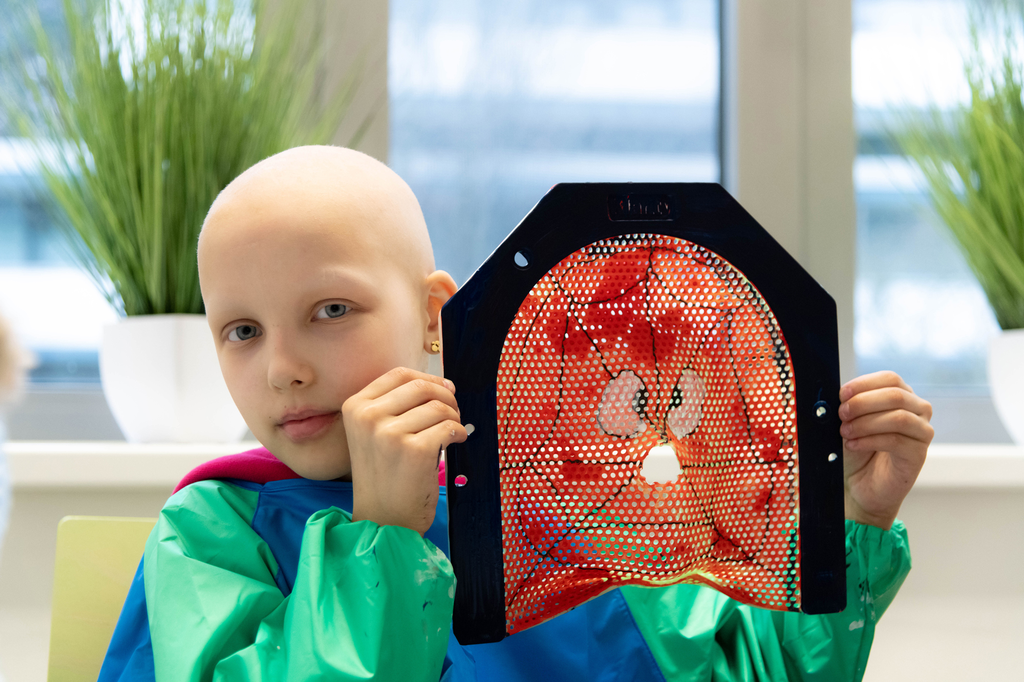
Colours and
superheroes
for courage
They are part of everyday life at the WPE: the light green masks that are customised for each patient. Especially when irradiating brain or head and neck tumours, they support the head in such a way that no involuntary movement can interfere, as this is the only way to ensure precise irradiation. A new art therapy project at the West German Proton Therapy Centre now aims to make it easier for children and young people to use the mask – and turn the medical object into their own empowering creation. Even in a superhero look if desired.
The greatest advantage of proton therapy is also its crux: the high precision of the radiotherapy protects the still immature, sensitive tissue of the patients as much as possible, but makes an optimal position that is always the same throughout the entire treatment period of several weeks an absolute prerequisite. In other words: the therapy stands and falls with the precision of the planning and exact positioning. Doctors, physicists and MTRAs at the WPE therefore work together on precise radiotherapy plans for each individual patient. The radiographers’s tools include special positioning cushions and the typical green, customised plastic mesh masks. A shorter version covers the face and head. A longer version reaches down to the shoulders. If necessary, the radiation points of the lymphatic drainage areas can also be marked in these head and neck masks, for example when radiating ENT tumours.
However, not all patients can cope with the confinement of the mask and the associated immobility; children and adolescents in particular sometimes struggle with this challenge. Annelie Ender, radiographerand dedicated art therapist at the WPE: “Unfortunately, it is difficult to convey to some children that they really have to lie still for long periods of time. The situation as such is anything but easy – without parents, in a highly technical gantry and then with a mask over their face. That’s why we try to make the mesh masks as positive as possible for the children as soon as they are customised.”
Art therapy at the University Medical Centre Essen
The art therapy programme for children with cancer at Essen University Hospital has been supported by the University Medicine Foundation for many years. Art therapy projects at the paediatric clinic at Essen University Hospital in particular help many of the approximately 30,000 children and young people being treated there to deal with their illness in a creative way and express their fears and worries, but also their wishes and hopes. Offers such as these go beyond standard care and can only be realised with additional financial support. The project at the WPE was made possible thanks to the support of the Evonik Foundation in the amount of 30,000 euros for two years. In addition to masks, patients can also creatively design cushions or canvases. Some even make their own masks for their cuddly toys.
- Website of Stiftung Universitätsmedizin Essen
- Website of Evonik Stiftung
The art therapy mask project launched at the WPE a year ago is aimed precisely in this direction: “Right from the start, we wanted to do everything we could to make treatment as pleasant as possible for our young patients and at the same time give them the opportunity to actively shape their treatment themselves. This boosts their self-confidence and can have a positive effect on their well-being during treatment,” says Prof Dr Beate Timmermann, Director of the Clinic for Particle Therapy and Medical Director of the WPE, explaining the background. In practice, this means above all a great deal of creativity. Under the guidance of Annelie Ender, the children with cancer give their masks a colourful, individual look and ultimately a new self. “Possible negative associations,” summarises Ender, “which could be related to the mask, are replaced by something positive, something they have created themselves”. And so many a simple mask is currently being transformed into a superhero “overcoat” bursting with colour, which protects and gives strength.
In fact, says Annelie Ender, “the aim is to create a sense of identification that, in the best case scenario, culminates in the children really looking forward to putting on their own personal mask”. At the end of the therapy, the masks naturally go home with the children. As a unique memento that can be presented to family and loved ones. And as a very personal reward for the enormous courage of the WPE’s youngest patients.
